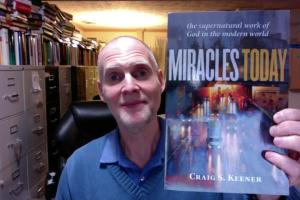From Moses parting the Red Sea, to Jesus healing lepers, to the Lady Fatima making the sun fall, people have reported miracles for centuries. What are miracles, and do they still occur in our secular age? Contrary to modern day skeptics, Dr. Craig Keener not only affirms their reality but claims they still happen today. He documents numerous examples in his massive two-volume set appropriately entitled, Miracles. He has also just written a user-friendly account of miracles entitled, Miracles Today. Here is how Dr. Keener answers seven important questions on miracles:[1]

-
What is a miracle?
The term usually translated as “miracle” in the New Testament means an “act of power,” typically functioning as a sign that invites people’s attention for God’s purposes.
Theologians often define a miracle as a “special divine action.” It is differentiated from God’s general divine action in the ways he designed nature to act regularly. Many Christians throughout history have defined miracles as God’s acts “above” nature that generate awe.
Eighteenth-century philosopher David Hume, however, created a new influential definition in his essay on miracles in an attempt to define them away. He defined miracles as violating natural law, and defined natural law as what cannot be violated.
But Hume’s new definition refuted a straw man. Most biblical miracles do not violate natural law (apart from creation, the virgin birth, and Jesus’s resurrection to a new order of existence). Christians do not consider the Divine law-giver as subject to laws he designed.
-
What is the purpose of a miracle?
Miracles draw attention to God, his kingdom, and his Son. God often acts in ways that appear to us less dramatic, but he shows “acts of power” as signs pointing to his future kingdom and/or Jesus’s identity.
In Matthew 11:5 and Luke 7:22, Jesus evokes Isaiah 35 and 61 to show that his healings and preaching are a foretaste of the promised kingdom restoration. We see in Matthew 12:28 and Luke 11:20 that his exorcisms function the same way. In John’s Gospel, miracles are signs to point people to Jesus’s identity, inviting faith.
Throughout the Gospels and Acts, miracles invite attention. Thus, in Acts 14, the signs God performs through Paul and Barnabas draw attention to their gospel message, which results in some people believing that message—and other people persecuting them. But it is hard for people to simply remain neutral or ignore the message when God performs acts of power in front of them.
-
Are there examples of modern-day miracles such as the blind being healed?
In 1959, macular degeneration, which is organic and medically incurable, made a young woman legally blind. She read Braille and, after she married, never saw the face of her husband or daughter.
In 1972, her husband felt moved to pray for her, and she suddenly could see for the first time in nearly thirteen years. Her eyesight remains intact, and the case has been published in a medical journal (see my book, Miracles Today, ch. 17, for documentation). This is just one case among many cases of blindness healed that we could recount.
-
Are there examples of modern-day raising the dead?
It’s hard to narrow this down. I usually like to mention the raising of my sister-in-law after three hours without breathing, but that was not under clinically observable conditions. There are, however, clinically observed accounts. One is from Sean George, a consultant physician at Kalgoorlie Hospital in Australia. He died from a heart attack, and despite thirteen shocks and four thousand chest compressions, he had been dead for 85 minutes by the time his wife, also a physician, arrived. She cried out to God, and suddenly his heart started again without human intervention.
Although irreparable brain damage begins within six minutes without oxygen, and all his systems had shut down, Sean awoke three days later without brain damage, and is back to work. He has put the evidence, including the original defribillator logs, on his website, so the documentation is publicly available (see further, Miracles Today, ch. 27).
-
What about nature miracles. Do they still happen?
When I was a young seminary professor, the campus ministry at the adjoining college was planning an outreach for a particular day. When that day arrived, however, rain was pouring down and the weather forecast was rain all day. One student, Sharon, a sophomore biology major from another college, led us in prayer for the rain to stop. “It can’t hurt,” I thought, joining in the circle.
When we said, “Amen,” the rain stopped, and within a few minutes we were bathed with sunshine, which continued the rest of the day. I have plenty of similar reports; I just choose this one because I’m an eyewitness (and this allows me use a different case in answer to question #7).
-
What are some miracles, if any, that are captured on film?
A car accident left gospel singer Delia Knox paralyzed for 22 years. Unable to feel or control her legs from the hips down, she sang from a wheelchair in the ensuing years, as plenty of older videos and witnesses attest.
But after 22 years, as people were praying for healing during a church service, she suddenly experienced feeling in her legs and began to walk. Because her muscles were atrophied from years of nonuse, she needed help, and critics mocked the online video of her first steps. A month later, however, another video shows her walking normally. There are plenty of videos, but one link that collects several is:
Paralytic Woman Bound to Wheelchair for 22 years
-
Craig, have you experienced miracles yourself?
When I was starting my master’s degree and lacked money to see a physician, I (apparently) broke my ankle. Even after it healed I could not run anymore for the next two years, until one day I had a special experience of faith during prayer and my ankle was healed. The next day I ran up six flights of stairs to celebrate!
But if I can slip in another, earlier experience here—this one happened a few years after my conversion from atheism. I was helping in a nursing home Bible study where, every week, one lady would protest repeatedly from her wheelchair, “I wish I could walk!” One day the Bible study leader, a seminarian from Fuller, grabbed her by one hand and commanded her to walk in the name of Jesus. Much to her astonishment and mine, he walked her around the room, and from then on she could walk.
By the way, I do warn my seminary students not to try this unless they are absolutely sure that God is leading them to do it. But we were all quite pleased with the outcome that time!
Here are some final thoughts from Craig Keener regarding miracles:
By definition, miracles are not part of the regular course of nature. God has built healing mechanisms into our bodies, has provided us with the fruits of medical science and technology, and has given us various natural means to work for our health. God works through all these means. But because they can appear to us as the regular course of nature to which we are accustomed, we sometimes do not pay attention to them. When God heals through these other means, we can still thank him for answering our prayers.
When God acts in a special way that we call a miracle, it demands attention and invites people to faith in him. So long as this age persists, however, we have only a foretaste of God’s kingdom, not its consummation. Until then sickness and death remain part of this world, a reality the Bible takes for granted (e.g., 2 Kings 13:14; Luke 14:13; 2 Timothy 4:20).
When God does a miracle for anyone, however, it is a gift to all of us, because it is a foretaste of the kingdom. It is a reminder to us that God has not forgotten his promise. A new day is coming when God will wipe away all tears from our eyes.
If you want to read more samples of that foretaste, there are quite a number in my Miracles Today: The Supernatural Work of God in the Modern World (Grand Rapids: Baker Academic, 2021).

[1] I raise the questions prompted by his new book, Miracles Today: The Supernatural Work of God in the Modern World (Grand Rapids: Baker Academic, 2021), and Craig personally answers each of them.
Image 1: Jesus Christ God Holy Spirit Gospel Bible Red Sea via pixabay.com; Image 2: Craig Keener self-portrait used by his permission.













